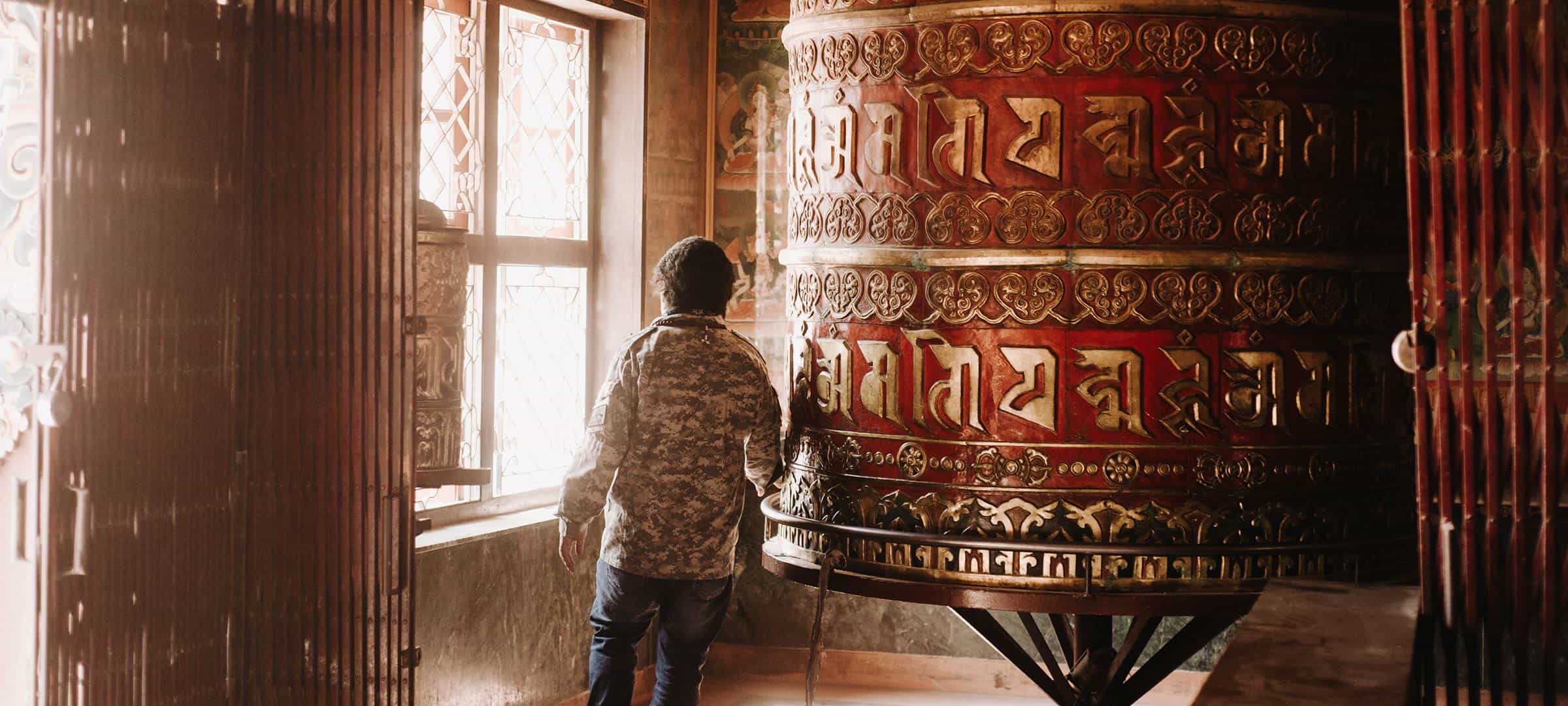Below the duvet of evening we took the lengthy winding highway to Naktapor, hoping to catch the primary rays of the rising solar from up within the mountains. The air was cool as we stepped out of the van and made our strategy to the lookout level. We watched because the fog slowly lifted, revealing the valley under. Because the sky grew paler, the Himalayas got here into view. Stretching out within the distance in direction of the east, the snow lined peaks rose into the clouds.
The legendary vary, residence to Everest, has grow to be a pilgrimage web site for mountaineers for over a century. Lethal ascents have made legends of those that have conquered their summits. However there’s one identify that is still a continuing within the tales of those exploits—Sherpa. The identify belongs not solely to the guides tasked with mapping out the route on these perilous expeditions, but in addition belongs to a bunch of individuals indigenous to the vary of mountains that share the border with Tibet. Sherpa, that means “folks of the East,” is a surname given to these born within the japanese ranges of the Himalayas.
Trying to uncover the knowledge of the Sherpa, the Altitude Sports activities crew headed to Kathmandu, to satisfy with the folks from Sherpa Journey Gear, the fashionable model that allowed its founder, Tashi Sherpa, to present again to the folks of Nepal whereas paying tribute to the unsung heroes of Everest.
Our lodging for the week, a comfy mattress and breakfast, had been housed within the constructing that additionally served as the pinnacle workplace, pattern studio, and fundamental storefront for Sherpa Journey Gear in Nepal. It was right here within the early hours of the morning that Mingma Sherpa greeted us upon our arrival from the airport. An proprietor of considered one of Sherpa’s three shops in Nepal, and a model ambassador for over a decade, Mingma can be our information to the traditional temples and trendy points of interest of Kathmandu.
We spent our first days exploring the town and its surrounding areas, beginning in the primary vacationer space of Thamel earlier than heading in direction of the outskirts of Kathmandu to the Swayambhunath Stupa. Colloquially referred to as the Monkey Temple, it will get its identify from the furry inhabitants that decision the temple space residence. They primarily stored to themselves as we climbed the steps, the place we took within the breathtaking views overlooking Kathmandu Valley.
Our arrival additionally coincided with the start of the Holi Competition, an annual occasion held in India and surrounding international locations with giant Hindu communities, celebrating the arrival of Spring. We spent our second day journeying by means of temples and slender streets by rickshaw in direction of Basantapur to Patan Durbar sq. the place the primary festivities had been being held. Alongside the way in which we had been greeted by smiling faces and cries of “Glad Holi” as we had been lined in powders of each hue. Giant crowds gathered within the sq. and we managed to catch a fowl’s eye view of the festivities from one of many close by rooftop terrasses.
As we took in these vibrant scenes, after two days spent exploring the slender alleyways and bustling streets, one factor was clear—Kathmandu is stuffed with color. From the intricately painted deities featured on the buddist temples, to the multi-coloured buildings and freshly-coloured faces of the competition individuals, it was laborious to not get misplaced within the palette, and sounds, of Nepal’s capital.
Mingma guided us by means of our first days and shared with us the importance of the ever present prayer flags in Nepalese tradition, one steeped in Tibetan Buddhism. These vibrant flags represented the 5 parts—blue for water, yellow for earth, inexperienced for metallic, pink for hearth, and white for water and clouds. It’s stated that the flags blowing within the wind assist unfold the messages of peace, knowledge and pleasure that they characterize.
Hanging from temple domes, rooftops and Himalayan peaks, the flags are an essential a part of the nation’s heritage. Sherpa Journey Gear’s attire can also be firmly rooted on this heritage: from the hand-knit hats made at a neighborhood manufacturing facility, to the prayer flags featured on the zippers and sleeves of their attire—there’s as a lot give attention to the place the clothes is from as the place the clothes can take you.
We took the three flights of stairs down from our rooms, previous the pinnacle workplace and the shop, to the manufacturing studio, the place we had been met by Tsering Sherpa, son of founder Tashi, and his spouse Tenzin Dhasel. Tsering, who grew up in Seattle the place Sherpa’s head workplace was situated, returned to Nepal in 2015 to be along with his spouse. Collectively they oversee operations, together with the manufacturing of Sherpa’s newest attire made in Nepal and India, from the proto stage to the completed product.
Within the studio we had an opportunity to talk with Sherpa’s Chief Technical Officer Ram Kumar. Though the model has solely been round since 2003, Ram and Tashi’s working relationship goes again 35 years once they had been within the materials and textiles business. Ram is liable for designing the patterns earlier than starting the pattern course of. Whereas the unique patterns and designs are created manually, Sherpa ensures that their manufacturing studio has the most recent equipment to take care of effectivity and business requirements. For Sherpa, having the most recent know-how additionally means there’s little or no waste.
Whereas the machines can guarantee precision, they can not account for extra material. Having the design studio under the primary storefront means they will make small manufacturing runs, and create merchandise unique to the shop. These are sometimes completed utilizing extra material, which provides them the liberty to check out new designs and to create items particular to their market—like scrunchies (referred to as Puna, that means “once more” in Sanskrit). For the items of material which are too small or unusable throughout manufacturing, they’re put apart for Khaalisisi, a recycling program that collects leftover materials and supplies.
The studio gave us the chance to see what manufacturing was like on a smaller scale, however for mass manufacturing we headed to the model’s printing studio the place we met Subrat Dhittal, the pinnacle of the studio and Tashi’s enterprise associate for over 30 years. The studio makes use of the most recent know-how which prints the designs straight onto the clothes, then heats them as a type of laminate to make sure sharper detailing and no peeling when the clothes is washed. Digitized printing, and paper and water-based glue to carry the designs in place, additionally means much less errors and a extra sustainable technique of manufacturing.
The ladies’s knitting program is an initiative arrange by Sherpa. Whereas the manufacturing facility has been in enterprise for over 30 years, the ladies’s program has been in place because the model’s inception in 2003. With yarn from New Zealand, the ladies are liable for knitting all of Sherpa’s wool hats. There are 22-25 girls working on the manufacturing facility full time, and whereas some had been employed by means of an employment community, others had been employed by means of suggestions from family and friends.
Rita, who has been working on the manufacturing facility for 12 years, spends a number of her spare time knitting, and earlier than she was employed by Sherpa, would usually come to the manufacturing facility to purchase yarn. The chance introduced itself to make further revenue for her household and shortly she, together with the remainder of the ladies from this system had been knitting 4 to 5 hats every day, working at their very own tempo and being paid primarily based on manufacturing. When demand will increase, the manufacturing facility will rent upwards of 300 freelancers. Though they’re supplied the choice of working from residence, many of the girls select to come back into the manufacturing facility to knit, the place they will sit and chat within the relaxed atmosphere of the manufacturing facility’s courtyard and knitting room.
The van navigated by means of the busy metropolis streets with ease. The chaos outdoors didn’t part Mingma in any respect as he advised us concerning the Sherpa Journey Gear Fund. We had been on our strategy to go to the scholars who had been given the chance to attend boarding faculty in Kathmandu—all because of the fund arrange to make sure that each merchandise offered supplies a day of college for the scholars.
Mingma and his spouse Yangji have been working with the scholars because the program’s inception eight years in the past. They’re a part of the choice committee that chooses the scholars who got here from small mountain villages within the Solukhumbu District, villages like Namche Bazar the place Mingma was raised. As the corporate grew, so too did the scholarship program. This system, which began with solely three college students, has through the years grown to 11, with college students starting from 5 to fifteen years outdated. This progress has additionally given Sherpa the chance to make an excellent larger influence by partnering with a further group that helps education schemes throughout Nepal.
We arrived on the faculty simply earlier than lunchtime and had been greeted by the scholars of their brilliant pink uniforms. They led us to the library, the place we sat down and talked a bit about this system, and what they deliberate on doing afterwards. For a few of the youthful children like Dawa, this wasn’t a direct concern, however for Jigmey, the oldest pupil who had been in this system because the starting, it was time to organize for the following part of his schooling the place he deliberate on finding out Laptop Sciences.
The scholars had been comfortable to speak about their favorite lessons, their favorite music, and their favorite athletes. As soon as we had an opportunity to go across the circle, they steered a tour of the varsity and their school rooms. Some who had been shy at first grew extra talkative as we walked by means of the hallways, mentioning the place Maths and English had been taught, and waving at their pals in the midst of their classes.
The tour continued over on the dormitories. As they confirmed us the place they spent most of their mornings and evenings, they described a typical day, one which began at 5 AM and went straight by means of till 5 PM, with a number of breaks all through the day to interrupt up lessons and research intervals. The college is their residence away from residence, however Sherpa will usually arrange a number of journeys all year long for the scholars to return residence and go to their household. For individuals who don’t have the prospect to go residence, they are going to usually stick with Mingma and his spouse, whom the scholars affectionately discuss with as ‘Aunty and Uncle.’
The tip of the tour coincided with the bell for recess. Whereas we may have spent the entire day with them, we didn’t wish to preserve them from spending time with pals and working across the playground earlier than the beginning of their afternoon lessons. As we loaded into the van, they waved at us and stated their goodbyes, laughing as we echoed one of many Nepalese phrases that they had taught us—feri bettum la (till we meet once more).
On our strategy to the varsity we stopped on the Boudhanath Stupa. Positioned on the outskirts of Kathmandu Valley, there are a variety of legends surrounding its building. The Tibetan buddhist fable says {that a} native buffalo farmer wished to construct a stupa however she didn’t have the land. She went to the King, who advised her if she introduced him a bit of buffalo pores and skin she may construct one the scale of the pores and skin. The girl, seeing the only piece of pores and skin for greater than it was, minimize it alongside the sides till it unravelled right into a single thread that expanded approach past its unique type. Immediately the stupa is among the largest on the planet.
Sherpa Journey Gear, based in 2003, began out as a small firm and has grown through the years into a worldwide model. Tashi, the founder, noticed the potential to do extra than simply manufacture clothes. By means of assist from the sale of each merchandise offered, he has established the Sherpa Journey Gear Fund, which permits college students from distant villages within the Himalayas to attend faculty and earn an schooling. In working with the ladies’s manufacturing facility, Sherpa has given many ladies the prospect to earn further revenue for themselves and their households. Growth has allowed Sherpa to not solely modernize their services however make sure that the material from the clothes they make could be given a second life—it’s no coincidence that Sherpa’s fundamental brand, the infinite knot, represents reincarnation. They appear to the previous, current, and future for inspiration, and most of all they perceive the influence {that a} single thread can have, as a result of, in their very own phrases, Sherpa is a “small model dedicated to creating a huge impact.”
Uncover Sherpa Journey Gear
From heritage knitwear to the most recent technical gear and attire. Store Now










